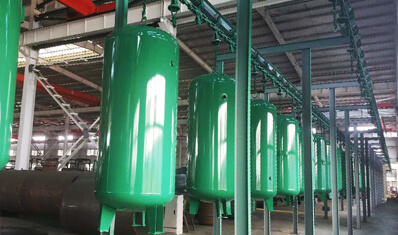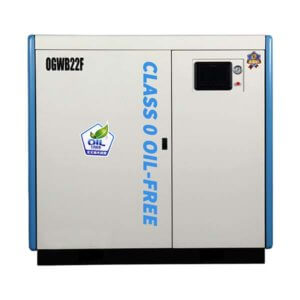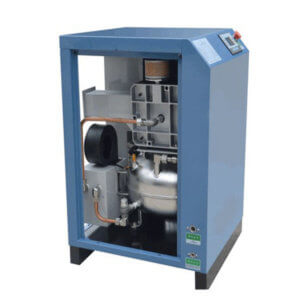Contents
The rotary screw compressor is a mechanical compressor that uses two intermeshing rotating screws to compress the air. These compressors are commonly used for home and business use because they’re highly efficient, can generate high-pressure levels, and come in a portable size.
In the past decade or so, portable air compressor tanks have become more popular with the industry. These tanks come in various sizes for both small and large compressors. Typically, a smaller tank is used with a portable screw air compressor, while a larger tank should be used with stationary units.
Types of Air Receiver Tank
Types of Air Receiver Tank
Two types of air tanks can be used with rotary screw compressors. These are the bladder tank and the open-top tank.
An open-type compressor is more prevalent among homeowners, while commercial units typically use an enclosed bladder tank to prevent any possible leakage or damage to the equipment.
A closed-type compressor has a sealed bladder inside, making it impenetrable to outside forces (water in particular). This storage unit is maintenance-free, easy to clean, and virtually leakproof compared to its counterpart. It’s also incredibly durable because it doesn’t have any rubber seals that can wear down over time with heavy use.

A rotary screw compressor’s tank functions
A rotary screw compressor’s tank functions
The tank’s essential functions are to store compressed air and reduce the pulsation and noise associated with the compressor.
Compressed air is drawn from the atmosphere by the compressor. The compressed air is then stored in the tank until it’s needed. Because the pressure in the tank increases with each compression cycle, the tank helps regulate and stabilize the pressure output of the compressor. This is important because it prevents fluctuations in pressure that could damage equipment or injure personnel.
In addition, when a rotary screw compressor is used for long periods, it can produce a great deal of noise. The tank absorbs some of the sound energy, which helps reduce the noise levels.
How to select a tank for your compressor
How to select a tank for your compressor
The size of the compressor motor:
The tank should be sized to match the capacity of the compressor motor. Usually, a larger air receiver is used with a stationary unit, while a smaller receiver is used with a portable type.
Working pressure:
This is important for both stationary and portable units. The pressure in the tank must reflect that of the output pressure from the compressor. In other words, if your screw compressor produces 100 psi as its maximum working pressure, your storage tank should hold at least as much as this level. This means you either need one large tank or enough to make up for this capacity.
For example, two 50-gallon tanks can be connected to a 100-gallon storage solution for a 200-psi screw compressor.
How much air the compressor will need to supply:
Compressors use different tools and equipment depending on how they are used. Larger pieces of equipment such as pneumatic drills, impact wrenches, and sanders require much more air than nail guns or spray painting tools.
What kind of portability you need:
Depending on what you intend to use the compressed air for, you may need your system to be very portable. If this is the case, you’ll want to select an air receiver tank that has wheels and a handle so that it can be moved around easily.
The construction material of the storage tank:
The material used in construction will determine how durable the storage solution is and how much weight it can hold. Steel tanks are the most common and are very strong, but they can be pretty heavy. Aluminum tanks are lightweight but may not be as durable as steel tanks.
The maximum allowable pressure:
This is the maximum pressure the storage tank can hold before it ruptures. If possible, choose a tank with a working pressure higher than your compressor’s maximum.
The ambient temperature and climate where the compressor will be used:
It is crucial to select a tank that will function properly in low and high-temperature ranges in extremely cold or hot environments.
When choosing a rotary screw compressor, it is vital to select a model that has a tank that is large enough to meet your needs. A smaller tank will not store enough compressed air to meet the demands of a more significant appliance or tool. Tanks that are too large will increase compressor costs.
Essential factors to consider when using rotary screw compressor:
- The tank must be securely mounted in place
- Always ensure that the tank is well ventilated
- Do not use the pressure washer to fill the tank with water
- Do not connect the compressor directly to an ungrounded outlet.
Air Compressor Tank Maintenance Tips
Air Compressor Tank Maintenance Tips
Once your rotary screw compressor’s air tank has been properly installed, and it’s essential to keep up with routine maintenance so you know it’s working correctly.
Keep your tank in good shape by doing these things:
Maintaining the compressor’s performance requires regular cleaning. Less than regular cleaning can lead to buildups inside the unit, damaging vital valves, cylinders, and other moving parts.
1) Keep the surrounding areas around the external surfaces of the tank free of dirt and debris.
2) Periodically inspect the compressor tank for any dents, leaks, rust, or other signs of damage.
3) Inspect all valves and fittings on the air compressor for damage and replace them as needed.
4) Ensure that all electrical connections to the compressor unit are secure and free of corrosion or dirt.
5) Ensure that your screw air compressor is clean and dry before using it. If there is moisture in the tank when you first turn it on, allow it to warm up before continuing use. This will help prevent condensation from forming inside the unit, leading to internal problems down the line, such as corrosion or water damage to internal components.
A rotary screw compressor is an excellent investment for anyone who needs a reliable and durable air compressor. When selecting a suitable model, it is crucial to consider the abovementioned factors to ensure you get a unit that meets your specific needs. By following these tips and keeping up with regular maintenance, you can ensure that your compressor tank will last for many years to come.









Leave A Comment